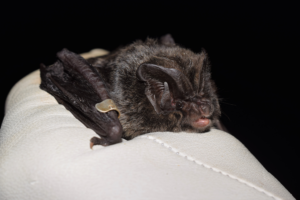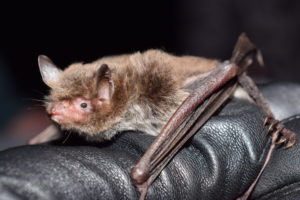Bats are amazing. They are the only mammal that is able to actively fly, rather than glide. They can live for an incredibly long time for such a small mammal; the oldest known bat reached 41 years old. They fly using echolocation, which builds up a 3D picture using sonar. Bats occupy the most diverse range of habitats and ecological niches out of all other mammal groups and can be found on all continents except Antarctica. Some eat fruit, some eat insects. Some bats eat small mammals or fish, others drink blood – animal blood, not human (or do they?!).
Bats are also good indicators of a healthy ecosystem, help pollinate many of the fruits that we eat and depend upon, and provide a good pest control service, eating thousands of midges and mosquitos. All of our UK bats are insectivorous and each has their own little specialism; Daubenton’s catch insects whilst flying over water, scoping them up using their tail membrane, Long-eareds are in a continuous arms’ race with the moths that are evolving methods to avoid predation, Bechstein’s and Barbastelles are ancient woodland specialists.
Of the 18 species considered to be resident in the UK, Cambridgeshire has 12 of them:
- Common pipistrelle – Pipistrellus pipistrellus
- Soprano pipistrelle – Pipistrellus pygmaeus
- Nathusius’ pipistrelle – Pipistrellus nathusii
- Noctule – Nyctalus noctula
- Leisler’s – Nyctalus leisleri
- Serotine – Eptesicus serotinus
- Brown long-eared – Plecotus auritus
- Daubenton’s – Myotis daubentonii
- Whiskered – Myotis mystacinus
- Brandt’s – Myotis brandtii
- Natterer’s – Myotis nattereri
- Barbastelle – Barbastella barbastellus


Other UK species that aren’t present in Cambridgeshire include:
- Grey long-eared – Plecotus austriacus
- Bechstein’s – Myotis bechsteini
- Greater horseshoe – Rhinolophus ferrumequinum
- Lesser horseshoe – Rhinolophus hipposideros
- Alcathoe – Myotis alcathoe
- Greater mouse-eared – Myotis myotis
Additional vagrant species recorded sporadically within the UK in recent years include:
- Kuhl’s pipistrelle – Pipistrellus kuhlii
- Geoffroy’s – Myotis emarginatus
- European free-tailed bat – Tadarida teniotis
Bats In Decline
Bats are very vulnerable to change, and although they can often be seen foraging at dusk or dawn, populations are in general decline. Whether it is because of a loss of roosting sites due to tree felling or development, agricultural intensification which supports fewer insects, habitat loss or fragmentation, or direct mortality from traffic, cats, or wind turbines, our landscapes are able to support fewer numbers and fewer species, especially bats who depend on particular habitats to survive.
The behaviour of bats is complex and often mind-boggling. Although new research is revealing more about bats than ever before, we need to better understand their distribution on a county-wide and UK-wide scale, and their habitat preferences and how they use the landscape.
